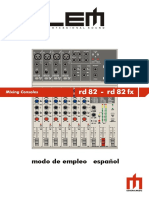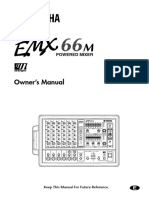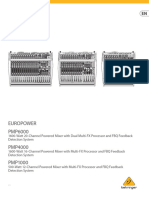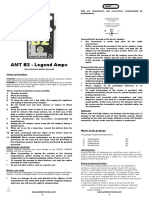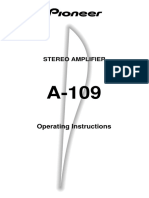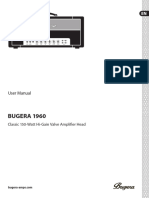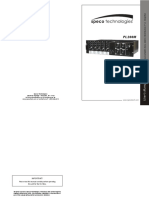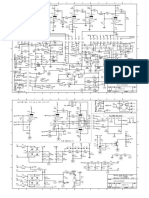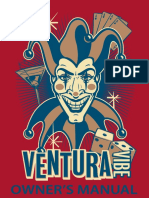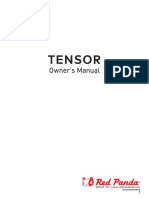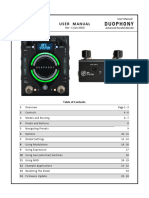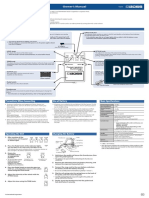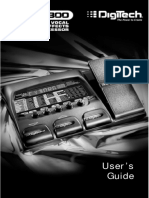Midi jmp1
Uploaded by
MichalMidi jmp1
Uploaded by
MichalJMP-1
HANDBOOK
Downloaded from www.Manualslib.com manuals search engine
ENGLISH
From The Chairman
I would like to thank you personally for selecting the JMP-1 MIDI Pre-amp.
As our first venture into MIDI controlled guitar equipment, many hours of
development have been spent ensuring that it fulfils the functions that you really
need to cope with todays widely varied playing environments. We have always
worked very closely with guitarists from many different fields and their valuable
input has been an essential ingredient in the creation of the JMP-1.
My design team is made up of guitar players who fully understand the needs and
realities of guitar performance. They have had a free hand in making this pre-amp
sound quite simply the best.
My confidence in their ability is absolute and it gives me great pride to see and hear
the traditions of Marshall improved through progress, whilst retaining the classic
tonal authority that is the Marshall hallmark.
Please read this handbook carefully before operating your JMP-1 so that you can
fully enjoy the advantages of our research and technology.
Downloaded from www.Manualslib.com manuals search engine
! WARNING! - Important safety instructions
WARNING: This apparatus must be earthed!
A. PLEASE read this instruction manual carefully before switching on.
B. ALWAYS use the supplied mains lead, if a replacement is required please contact your authorised Marshall Dealer.
C. NEVER attempt to by-pass the fuses or fit ones of the incorrect value.
ENGLISH
D. DO NOT attempt to open the apparatus, there are no user serviceable parts.
E. Refer all servicing to qualified service personnel including replacement of fuses and valves.
The internal battery is not user changable. Servicing is required when the apparatus has been damaged in any way,
such as when the power supply cord or plug is damaged, liquid has been spilled or objects have fallen into the apparatus, the
apparatus has been exposed to rain or moisture, does not operate normally or has been dropped.
F. NEVER use an amplifier in damp or wet conditions. No objects filled with liquids should be placed on the apparatus.
G. ALWAYS unplug this apparatus during lightning storms or if unused for long periods of time.
H. PROTECT the power cord from being walked on or pinched particularly at plugs, convenience receptacles and at the point where
they exit from the apparatus.
➲ Note: This equipment has been tested and found to comply with the requirements of the EMC directive
(Environments E1, E2 and E3 EN 55103-1/2) and the Low Voltage directive in the E.U.
➲ EUROPE ONLY - Note: The Peak Inrush current for the JMP-1 is 800mA.
Note: This equipment has been tested and found to comply with the limits for a Class B digital device, pursuant to part 15 of the FCC rules.
These limits are designed to provide reasonable protection against harmful interference in a residential installation. This equipment generates,
uses and can radiate radio frequency energy and, if not installed and used in accordance with the instructions, may cause harmful interference
to radio communications. However, there is no guarantee that interference will not occur in a particular installation. If this equipment does
cause harmful interference to radio or television reception, which can be determined by turning the equipment off and on, the user is
encouraged to try to correct the interference by one or more of the following measures:
◆ Reorient or relocate the receiving antenna.
◆ Increase the separation between the equipment and the receiver.
◆ Connect the equipment into an outlet on a circuit different from that to which the receiver is connected.
◆ Consult the dealer or an experienced radio/TV technician for help.
➲ CAUTION: Any changes or modifications not expressly approved by the party responsible for compliance may void the users authority
to operate the equipment.
➲ Note: It is recommended that all audio and Midi cables used to connect to the JMP-1 are of a high quality screened type. These should
not exceed 10 metres in length.
➲ WARNING: Always ensure free movement of air around the apparatus! Particular care should be taken if installing the apparatus in a
rack, so that the flow of air is not impeded.
USA ONLY - DO NOT defeat the purpose of the polarised or grounding type plug. A polarised plug has two blades with one
wider than the other. A grounding type plug has two blades and a third grounding prong. The wide blade or the third prong are
provided for your safety. When the provided plug does not fit into your outlet, consult an electrician for replacement of the obsolete outlet.
Follow all instructions and heed all warnings
KEEP THESE INSTRUCTIONS !
Contents
Description Page number
Introduction 3
JMP-1 Front Panel Features 3
Rear Panel Features 4-5
When You Switch On 5
Creating Your Sounds 5
Storing Your Sounds 6
Sound Selections 6
Factory Sounds 7-8
Some Notes on MIDI 9
MIDI Channel 9
MIDI Mapping 10
Four Way Footswitch 11
To Re-initialise The JMP-1 11
System Exclusive 11-12
MIDI Implementation Chart 12
Connection Diagram A
Front and Rear Panel Layout B
Personal Sound Setting Table C
2
Downloaded from www.Manualslib.com manuals search engine
Introduction
The relationship between the guitarist and amplifier has been our prime concern since the earliest
ENGLISH
Marshall’s were produced. We always aim to give that extra edge, which can help to inspire the
player, fuelling creativity and the ability to express.
Advances in technology have allowed us to modify and enhance this basic principle for the benefit of
the musician. However, we have never lost sight of that extra emotional drive that only valves are
capable of producing. The whole character of our unique sound emanates from the breathing full
bodied pure tone of the valve.
Your JMP-1 MIDI pre-amp is a carefully designed coalescence between modern MIDI technology and
classic Marshall valve circuitry. It’s many tones are all valve generated and presented in a way that is
both comfortable and familiar to guitar players.
The digital control capabilities add a new degree of flexibility to the way in which the tones can be
switched and processed. The advantages provided by this level of control are truly astounding. After
studying the manual and with a little practical exploration, you will find an unbelievable range of sounds
and will very soon wonder how you managed without MIDI. The only limit is your own imagination.
JMP-1 Front Panel Features
1. Input Socket Connect the guitar to this socket.
2. Headphone Socket For the connection of stereo headphones.
Headphones with an impedance of 600 Ohms will give
the best performance. Connecting headphones does not
disable the outputs of the pre-amp.
3. Output Level Control Controls the volume level from the master left and right
outputs (Item 25).
4. Display The display is split into two sections and shows patch
and data information.
5. Patch Key Push this key to enter patch selection mode (0-99). The
patch key LED will illuminate to indicate patch mode.
6. Store Key Use this key to store a patch in the memory.
Operational Note:
Push once and the store key LED will flash. The data entry control (7) can now be used to change the storage
location. Pushing patch or a parameter key will abandon the store. Push the store key again to complete the store.
(Also see section Creating Your Sounds).
7. Data Entry Control This rotary control is used to increment/decrement data
information, or to select a patch in patch mode.
8. Volume Key Push this key to adjust the patch volume level between 0
and 20. The volume key LED will illuminate to indicate
that the volume parameter has been selected. The data
display will show the current value. The value can then
be adjusted using the rotary data entry control (7).
9. Gain Key Push this key to adjust the level of gain between 0 - 20.
10-13. Tone Control Keys These keys should be combined to shape the Bass,
Middle, Treble, and Presence tone parameters. They
can all be adjusted between -6 and +6.
Downloaded from www.Manualslib.com manuals search engine
14. Effect Key This key varies the mix of the stereo effects loop
between 0 and 12. At 0 only the direct signal is heard
and at 12 only the effected signal is heard. When at
12 the loop is effectively running in series i.e. no direct
ENGLISH
signal. This is ideal for use with a graphic equalizer or
compressor limiter. As the effect parameter level is
reduced, more direct signal is introduced as with a
parallel loop. This is best suited to Chorus, Delay,
Reverb etc.
15. OD1 Key This key selects overdrive 1, a warm vintage drive
reminiscent of Marshall Super Lead amps through to
modern day Master Volumes.
16. OD2 Key Selects overdrive 2. This a tightly focused high gain
drive which can be smooth or aggressive depending on
the E.Q. and gain settings.
17. Bass Shift This is a subtle low frequency character control which
can be switched in or out of any sound selection.
18. Clean 1 Key Selects Clean 1, which has a full warm character and
pure vintage tone.
19. Clean 2 Key Selects Clean 2. This has a bright sparkling tone ideal
for clean picking and ringing chords.
20. MIDI-Mapping Key The mapping function enables the mapping of incoming
MIDI patch messages to internal patches and outgoing
MIDI patch numbers to external devices. (See MIDI
mapping).
21. MIDI Channel Key This key selects the MIDI Channel on which the JMP-1
transmits and receives MIDI information.
22. Power Switch On/Off switch for mains power. Please ensure the
apparatus is switched off and unplugged from the mains
electricity supply before being moved.
Rear Panel Features
23. Emulated Outputs Left and right outputs featuring Marshall speaker
emulation. The volume level from these outputs is
controlled by the volume level parameter key (8) not by
the output level control (3).
Operational Note: Stereo Speaker Emulation.
The Marshall speaker emulation circuit is a special filter which gives a signal virtually identical in sound to a
speaker cabinet. This allows you to link directly to the PA and obtain a stunning direct sound in a live situation. In
the studio it will give a true guitar tone direct to tape.
24. Emulated Level Selection Switch Selection switch providing +4dB or -10dB output
levels on the speaker emulated outputs.
25. Master Outputs Left and right outputs for connection to a power amplifier.
26. Master Level Selection Switch Gives +4dB or -10dB Master output level options.
Downloaded from www.Manualslib.com manuals search engine
27. Effects Return Jacks Left and right jack sockets for connection from the
outputs of an external effects processor. If using a
mono effects processor the left hand return socket only
should be used. In this instance both the left and right
ENGLISH
master outputs and speaker emulated outputs will now
be working in mono.
28. Effects Level Selection Switch Provides level selection of +4dB or -10dB to match the
level of external effects processors.
29. Effects Send Jack Output for connection to the input of the external effects
processor.
30. Footswitch Socket Connection point for optional Marshall four way
footswitch to give 4 patch selection.
31. MIDI OUT Sends outgoing MIDI messages from the JMP-1.
32. MIDI THRU Sends out MIDI messages identical to those coming in
through the MIDI IN terminal.
33. MIDI IN Terminal to receive incoming MIDI messages from
external MIDI device.
34. MAINS INPUT Your JMP-1 is provided with a detachable mains (power)
lead which is connected here. Before connecting for the
first time, please ensure that your JMP-1 is compatible with
your electricity supply. If you have any doubt, please get
advice from a qualified person. Your Marshall dealer will
help in this respect.
When you switch on
When switching on the JMP-1, the unit will run through an Fig 1 Patch
initialising process and will then default to the patch number that Patch
Patch Data
was selected when the JMP-1 was last switched off (Fig1). Your
JMP-1 is now ready for action.
Store
Creating Your Sounds
Your JMP-1 is capable of producing a vast array of different tones, stored in the 100 available
patches. The simplicity of creating and storing these sounds is a major advantage and feature of the
pre-amp. A “Patch” is a combination of all the programmable elements that you put in, therefore if all
tone and volume selections are at 0, no sound will be produced. Each patch is made up of:
(A) The channel selection i.e. OD1, OD2, Clean 1, Clean 2 & Bass Shift
(B) The individual volume, gain, tone and effects levels that you have selected.
The first step is to select a patch by pressing the patch key (5) using the rotary data control (7) to reach
the desired patch number. The next stage is to “build” your required sound, firstly by selecting the
channel OD1, OD2, Clean 1 or Clean 2 with or without bass shift, then by selecting the volume, gain,
tone and effects levels. These controls work in exactly the same way as a normal Marshall amplifier,
where increasing the gain brings in more overdrive and the tone selections interact to “shape” the
sound.
The JMP-1’s controls are there to be used to the full and by experimenting with all the extremes you will
quickly understand it’s capabilities and build your own library of sounds.
Downloaded from www.Manualslib.com manuals search engine
Storing Yours Sounds
Fig 2 Store
When you are satisfied with the sound that you have created, storage
ENGLISH
is achieved in the following way. Push the store key (6) once , the LED Patch
Patch Data
will flash (Fig 2). Select the desired patch location using the data entry
control (7). (Pressing the patch or any parameter key will abandon the
Store
store). Push store a second time to complete the store
Memory Lock
A memory lock can be set to keep your data safe. This will disable
any functions that write data to the internal memory i.e Store, Fig 3 Memory lock Activated
Mapping, Channel & System Exclusive. If the memory is locked an 'L' Patch
Patch Data
will appear in the right of the display when you attempt a store (Fig 3).
At this stage the lock can be toggled on or off by pressing the Channel
Store
key.
Sound Selections
There is a definite identifiable character to the “Marshall Sound” throughout the years. largely derived
from the unique qualities of valve power. Our expertise in harnessing valve drive has been fully
exploited in the JMP-1 to recreate the various classic sounds and to generate new tones that will
become the classics of the future. Bearing in mind the variations in guitar types and styles, plus the
flexibility of the control parameters, the following guide gives an indication of each channel's basic
sound type.
Clean 1
This is a warm full bodied clean tone, ideal for rich chords, which can be softened for jazz tones or, by
adding gain, will suit clean lead lines with a hint of vintage distortion.
Clean 2
In complete contrast to Clean 1, Clean 2 is bright and glassy with a clear jangling tone. In addition it
contains the unique lively “edge” found only in the early JTM 45 and Super Lead Amps operating at
volumes just below distortion.
OD1
Features the purity of distortion from the golden age of the plexi glass Super Leads. As the gain is
increased you pass through degrees of distortion into a rich higher gain mode, with just the right
nuances for the modern blues rock player. Vintage crunch, modern metal and fat blues lead sounds are
all readily available.
OD2
Tightly focused stunning high gain is what you will find in OD2. Modern and aggressive, smooth and
fluid, the gain levels and singing tone of this channel will give you infinite sustain whilst retaining a pure
toneful quality.
Bass Shift
The Bass Shift option can be switched in or out of any channel selection. When selected it thickens the
bottom end of the sound and tightens the playing feel. On clean selections it adds body and on
overdrive provides the extra low end “throb” so essential for heavy rock sounds.
Downloaded from www.Manualslib.com manuals search engine
Factory Sounds
Your JMP-1 has 26 sounds ready programmed into patches 00-25. These patches have been
ENGLISH
programmed by experienced guitarists. They have also been used in full stage and studio performance.
These sounds can all be edited in the way described earlier and recalled if necessary using the
procedure described in the section-“to re-initialise the JMP-1.”
Pre set sounds
TITLE MODE B/S VOL GAIN BASS MID TREB PRES
00 Smoke-em OD 2 off 18 20 3 -3 3 1
01 Chunkus OD 1 off 17 20 1 -3 3 4
02 Sticky OD 1 on 15 13 1 2 6 3
03 Cleeeeen CL 2 off 20 9 3 -1 4 6
04 British Steel OD 2 on 17 16 4 0 4 1
05 Nasal Tone OD 2 on 16 20 0 1 6 6
06 Quo !!! OD 2 on 17 10 2 -2 6 3
07 Angus-Ho OD 2 on 17 14 0 -1 3 2
08 Filth OD 2 on 17 20 2 -6 6 6
09 Bloooz-O OD 2 on 17 11 2 -2 3 2
10 Bloooz-O+ OD 2 on 17 19 2 -2 3 2
11 Tej'as OD 1 on 16 14 1 -1 4 1
12 Modster OD 1 on 14 20 2 1 5 5
13 Biffa OD 1 off 15 20 2 0 3 3
14 More Gary OD 2 on 17 4 3 0 3 3
15 Mid-lands OD 1 on 14 17 2 6 3 3
16 Sunshine OD 2 on 15 10 1 6 -6 3
17 Britaevious CL 2 on 17 17 4 -2 6 6
18 Trash OD 1 on 17 9 4 -1 2 3
19 800's OD 1 off 16 15 6 0 3 3
20 LA Crunch OD 1 on 16 17 6 1 3 2
21 Crusher OD 1 on 18 12 5 -4 5 4
22 Grit Clean CL 2 off 16 19 3 -1 4 6
23 Shred Spread OD 1 on 17 20 5 0 6 6
24 Warm Grit CL 1 on 16 20 -1 3 6 6
25 Mellow CL 1 off 20 14 2 -2 1 1
Downloaded from www.Manualslib.com manuals search engine
Pre set sounds descriptions
TITLE MODE ATTRIBUTES PICKUPS COMMENTS
ENGLISH
00 Smoke-em OD 2 Lots of drive & sustain It starts here
01 Chunkus OD 1 Big, Ugly & Fat Gain controls "chunkiness"
02 Sticky OD 1 Edgy grime Big change for different guitars
03 Cleeeeen CL 2 Very Lots of headroom
04 British Steel OD 2 Warm & Heavy English overdrive
05 Nasal Tone OD 2 Thin, midrangy & cutting When tracks are full, this fits
06 Quo !!! OD 2 Bright crunch Rocks you all over the world
07 Angus-Ho OD 2 Mid '70s Marshall Tone
08 Filth OD 2 Bright, semi scooped Great for chords
09 Bloooz-O OD 2 Plexi 50 Watt Classic tone
10 Bloooz-O+ OD 2 Plexi 100 Watt As above, more aggressive
11 Tej'as OD 1 Punchy/dark drive Increase gain for vintage singles
12 Modster OD 1 Mod-ed Plexi More than enough
13 Biffa OD 1 Obnoxious overdrive In your face crunch
14 More Gary OD 2 JTM 45 on "6" Started it all
15 Mid-lands OD 1 Honky mid range voice Cuts through
16 Sunshine OD 2 Cleaner than you think! Increase Treb. for dark guitars
17 Britaevious CL 2 Modern clean - Pick's up EFX well Hi output pickups will distort
18 Trash OD 1 Very broad modern tone Fills up a lot of space
19 800's OD 1 JCM800 - Deliverin' the dB's Set bass to suit your guitar
20 LA Crunch OD 1 Mod-ed JCM800 on "5" Decrease Pres. for single coils
21 Crusher OD 1 JCM900 on "8" Mid control very effective
22 Grit Clean CL 2 Clean & on the edge Hi output pickups will distort
23 Shred Spread OD 1 Full scoop shred tone Bass control is the key here
24 Warm Grit CL 1 Dark & on the edge Hi output pickups will distort
25 Mellow CL 1 Clean & pretty Roll back guitar tone for full "Jazz"
8
Downloaded from www.Manualslib.com manuals search engine
Some Notes On MIDI
In a modern guitar set-up you might have a number of elements, a pre-amp and an effects processor or
ENGLISH
two. By using MIDI to link these devices together, you can control them all simultaneously. This is the
real use of MIDI for the guitarist (Musical Instrument Digital Interface). Most MIDI devices are equipped
with three MIDI terminals, MIDI IN, MIDI THRU and MIDI OUT. The connection between these terminals
is quite simple. A MIDI IN terminal would be connected to a MIDI Out or MIDI THRU terminal.
Messages are sent from a MIDI OUT terminal to a MIDI IN terminal.
MIDI messages received at the MIDI IN terminal are simultaneously routed through at the MIDI THRU
terminal. So the messages being sent via MIDI THRU are a direct copy of the messages received at
MIDI IN. The MIDI OUT terminal is not the same as the MIDI THRU terminal. The JMP-1 will send it’s
own MIDI messages via the MIDI OUT terminal.
There are various different MIDI messages that one device can send to another. The most important
message is the MIDI program (patch) change message. When the JMP-1 receives a program change
message it will call up a patch. Whenever the JMP-1 calls up a new patch it also sends a MIDI program
change message via the MIDI OUT terminal. Pressing a pedal on a MIDI foot controller will send a
MIDI program change message. Each MIDI program change message carries a number between 00
and 127 corresponding to the patch/program to be called up. The JMP-1 has 100 internal patches but
will respond to all 128 MIDI program change messages, by using a MIDI mapping table.
MIDI Channel
Another important thing to know about MIDI, is the idea of MIDI Channels. Most MIDI messages are
sent over a MIDI Channel, of which there are 16. In order for one MIDI device to communicate with
another, both devices must be operating on the same MIDI Channel.
The JMP-1 can be set to operate on any one of the 16 MIDI channels or in Omni mode. In Omni mode
the JMP-1 will respond to MIDI messages on all channels and will transmit on channel 1.
To Set The MIDI Channel: After pressing the channel key the display will indicate the current MIDI
Channel setting (Fig 4).
Fig 4 Channel selection Use the data entry control to select channels 1 to 16 or Omni
Patch
mode. Press the channel key again to store the channel setting
Patch Data and return to patch mode.
Store Note: The MIDI Channel setting is a ‘Global` parameter and
not stored with an individual patch. MIDI Channel setting is
retained whilst the unit is not powered.
Downloaded from www.Manualslib.com manuals search engine
MIDI Mapping
MIDI mapping is a simple and very useful facility, but it often confuses those who are new to MIDI. The MIDI
ENGLISH
Mapping table is stored in the memory and is made up of two parts, Input mapping and Output mapping.
MIDI MIDI MIDI
IN THRU OUT
Incoming MIDI
Data
4 Way Footswitch Input Output Mapping
(Patches 1-4) Mapping to MIDI Device 00-127
Call up Internal
Patch (00-99)
Front Panel
Control
Input Mapping
The input mapping table makes it possible to transpose any incoming MIDI Program Change number to
select any desired JMP-1 patch. For Example:
MIDI Program Change 124 could be mapped to JMP-1 patch 36, so whenever the JMP-1 received MIDI
Program Change 124 it would call up patch 36. The Input mapping function is invaluable if you are using
a MIDI foot controller that sends fixed Program Change messages.
Output Mapping
In the same nature as input mapping, the output mapping function can transpose any outgoing Program
Change message. If the MIDI OUT of the JMP-1 is driving an external effects processor, the JMP-1’s output
mapping can be used to select a particular effects program for each JMP-1 patch, with the advantage that
several JMP-1 patches can share the same program on the effects processor.
To Edit The Mapping Table:
1) Push Map key once to select incoming MIDI Program number. (See Fig 5). Use the data entry control to
select the incoming Program number (00 to 127). The decimal point signifies program numbers 100 and over.
2) Push again to select the Internal Patch to be called up (00 to 99) (See Fig 6).
3) Push the Map key a third time to set the outgoing MIDI Program Change message to (00 to 127) (See Fig 7).
4) Pushing the Map key a fourth time will store edits and return the JMP-1 to Patch mode.
Note: The mapping table is remembered whilst the JMP-1 is not powered.
Fig 5. Input Mapping Fig 6. Internal Patch Number Fig 7. Outgoing MIDI program
Patch Patch Patch
Patch Data Patch Data Patch Data
Store Store Store
Indicates 100-127
10
Downloaded from www.Manualslib.com manuals search engine
Four Way Footswitch
The optional Marshall four way footswitch (model MPM 4E) provides a simple means of selecting four
ENGLISH
patches.
The footswitch will call up patches one to four, however, the Mapping facility can be used to call up
any four of the 100 JMP-1 patches.
To Re-initialise The JMP-1
This procedure will re-load the factory sounds and reset the mapping table.
WARNING:- Your edited sounds will be lost if the unit is re-initialised.
Procedure, Hold down OD1 and Clean 1 whilst switching on the power.
Memory back-up
Fig 8. Error Detected
The JMP-1 has an internal battery back-up system to keep your patches
safe while the unit is switched off. This battery should last for several years. Patch
Patch Data
Every time you power up the JMP-1, a self check program is run. If any
Store
errors are detected an "E" will be displayed momentarily (Fig 8).
If this should occur repeatedly, then it is likely that the internal back-up
battery needs replacing. Contact your Marshall dealer as soon as
possible and back up your patches (see System Exclusive).
System Exclusive
By using system exclusive MIDI code, it is possible to dump all your patch and mapping settings to an
external MIDI device such as a sequencer or data filer.
To Transmit MIDI Dump Data:-
Connect a MIDI cable from the MIDI OUT of the JMP-1 to the MIDI IN of the receiving device. Press the
PATCH key and the VOLUME key together to begin transmitting. The display will indicate that a MIDI
exclusive dump is in progress by counting the data blocks (0 thru' 9) as they are transmitted (Fig 9).
When the transmission is completed, the display will return to normal.
To Receive a System Exclusive Dump:-
Connect a MIDI cable from the MIDI OUT of the transmitting device to the MIDI IN on the JMP-1.
(Ensure that the memory lock is off - see page 6)
WARNING:- Receiving a MIDI dump will re-write all your patches and mapping data, so be sure that
you are loading the correct data before you start. If you are unsure then make a back up of your current
data beforehand.
Fig 9. System Exclusive Dump
Execute the dump from the transmitting device. When the JMP-1
recognises the system exclusive code it will automatically respond by Patch Data
Patch
counting the MIDI data blocks as they are successfully received (Fig 9).
If this does not happen then re-check the MIDI connections and that you Store
are sending the correct file. When the transmission is completed, the
display will return to normal.
11
Downloaded from www.Manualslib.com manuals search engine
If their is an error (Fig 10) in the MIDI data the JMP-1 will abandon the
load and return to normal. Try the load again, the error could be due Fig 10. System Exclusive error
to a file corruption or faulty cable.
Patch
Patch Data
ENGLISH
Store
MIDI Implementation Chart
FUNCTION TRANSMITTED RECOGNIZED REMARKS
Basic Default 1 OMNI Memorized
Channel Channel 1-16 1-16
Default ✕ MODE 1
Mode Message ✕ ✕
Altered ✕ ✕
Note ✕ ✕
Number True Voice ✕ ✕
Velocity Note ON ✕ ✕
Note OFF ✕ ✕
After Key's ✕ ✕
Touch Channels ✕ ✕
Pitch Bender ✕ ✕
Control Change ✕ ✕
Program 0-127 0-127
Change True# 0-99 0-99
System Exclusive 0 0 See Note
System :Song Pos ✕ ✕
:Song Sel ✕ ✕
Common :Tune
System :Clock ✕ ✕
Real Time :Commands ✕ ✕
Aux. Messages :Local ON/OFF ✕ ✕
:All Notes Off ✕ ✕
:Active Sense ✕ ✕
:Reset ✕ ✕
Notes System Exclusive Patch dump and load when Memory lock is off.
Mode 1 :OMNI ON, POLY Mode 2 :OMNI ON, MONO 0:YES
Mode 3 :OMNI ON, POLY Mode 4 :OMNI ON, MONO ✕:NO
12
Downloaded from www.Manualslib.com manuals search engine
A
Downloaded from www.Manualslib.com manuals search engine
JMP-1 Front Panel Features
1 2 3 4 5 7 8 9 10 11 12 13 14
Output Level
Patch Volume Gain Bass Middle Treble Presence Effect
Patch Data Data Power
Input Phones
Store
- + OD1 OD2 Bass Shift Clean 1 Clean 2 Map Channel
VALVE MIDI PRE-AMP
JMP-1
Made in England
6 15 16 17 18 19 20 21 22
JMP-1 Rear Panel Features
MIDI FOOTSWITCH EFFECTS MASTER SPEAKER EMULATOR
Marshall Amplification plc. England
WARNING: Fire and Shock Hazard - Do not +4 dB +4 dB +4 dB
Expose Unit to Rain or Moisture. -20 dB -20 dB -20 dB
Shock Hazard This Unit Must be Earthed.
Do Not Open.
AVIS: Risque de choc Electrique - Ne Pas Ouvrir
MAINS INPUT WARNING: No User Serviceable Parts Inside.
Refer to Qualified Personnel.
230V ~ 50Hz 20 Watts IN THRU OUT SEND LEVEL R. RETURN L. RETURN LEVEL R. OUTPUT L. OUTPUT LEVEL R. OUTPUT L. OUTPUT
34 33 32 31 30 29 28 27 26 25 24 23
Downloaded from www.Manualslib.com manuals search engine
You might also like
- Europower pmp1680s 1600 Watt 10 Channel Powered Mixer ManualNo ratings yetEuropower pmp1680s 1600 Watt 10 Channel Powered Mixer Manual14 pages
- Europower PMP1680S/PMP980S/PMP960M: User ManualNo ratings yetEuropower PMP1680S/PMP980S/PMP960M: User Manual15 pages
- User Manual of The Marshall JMP-1 Preamp in SpanishNo ratings yetUser Manual of The Marshall JMP-1 Preamp in Spanish20 pages
- Behringer U Phoria Um2 Quick Start Manual 751845 PDF100% (1)Behringer U Phoria Um2 Quick Start Manual 751845 PDF39 pages
- Important Safety Instructions: Limited WarrantyNo ratings yetImportant Safety Instructions: Limited Warranty1 page
- Umc404hd Umc204hd Umc202hd Umc22 Um2 QSG WW PDF100% (1)Umc404hd Umc204hd Umc202hd Umc22 Um2 QSG WW PDF26 pages
- User Manual: QUESTIONS / COMMENTS CALL 888-842-6277 or EmailNo ratings yetUser Manual: QUESTIONS / COMMENTS CALL 888-842-6277 or Email11 pages
- Behringer Europower Pmp4000 Manual de Propietario100% (1)Behringer Europower Pmp4000 Manual de Propietario24 pages
- Ultragraph Pro FBQ6200/FBQ3102/FBQ1502: User ManualNo ratings yetUltragraph Pro FBQ6200/FBQ3102/FBQ1502: User Manual14 pages
- Mini Spot 30 Ring: User Manual Instrukcja ObsługiNo ratings yetMini Spot 30 Ring: User Manual Instrukcja Obsługi13 pages
- Kontakt Factory Library Documentation English100% (3)Kontakt Factory Library Documentation English111 pages
- Noël Akchoté - Guitar Styles & Techniques (Sheets)100% (3)Noël Akchoté - Guitar Styles & Techniques (Sheets)108 pages
- Music The Defintive Visual History (2013)No ratings yetMusic The Defintive Visual History (2013)1 page
- FPGA Design and Implementation of Electric Guitar Audio Effects - Project Report100% (1)FPGA Design and Implementation of Electric Guitar Audio Effects - Project Report38 pages
- User's Guide: Vocal 300 Manual 11/20/01 8:23 AM Page 1No ratings yetUser's Guide: Vocal 300 Manual 11/20/01 8:23 AM Page 115 pages






















